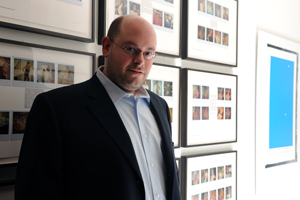Body of work
Anthropologist Matti Bunzl strives to bring humanities to the public.
By Katherine Muhlenkamp
Photography by Dan Dry

For Bunzl, anything relevant to the human experience is fair game for the Chicago Humanities Festival.
At lunch last spring, Matti Bunzl, PhD’98, then associate artistic director of the Chicago Humanities Festival (CHF), and Katinka Kleijn, a cellist in the Chicago Symphony Orchestra and member of the International Contemporary Ensemble, started talking about cosmetics’ carcinogenic properties. The subject had been on Kleijn’s mind, and with this year’s CHF theme, “the body,” Bunzl thought they might be able to work together. By the end of the meal, they decided to co-commission a suite for solo cello for the 2010 festival, with each of the eight movements written by a different avant-garde composer and titled after a different chemical compound found in blush.
Commissioning music inspired by makeup is not out of the ordinary for Bunzl. An anthropology professor at the University of Illinois at Urbana–Champaign, he began working with the 21-year-old festival in January. In August he was promoted to artistic director, a post he assumes officially when this year’s event ends November 14. The annual fall festival organizes cultural events throughout the city, featuring performers, scholars, writers, theologians, and policy makers, including a full day of offerings in Hyde Park. Besides Kleijn’s performance of Oil-Free Blush, this year’s schedule includes basketball legend Kareem Adbul-Jabbar talking about using one’s body for sport, a panel on how film has shaped the social consciousness of disability, and almost 100 other presentations. The CHF is ideal for someone like Bunzl, who says he’s “interested in everything.”
That intellectual curiosity attracted him to cultural anthropology when he left his native Austria in 1990 to begin undergraduate studies at Stanford. “What appealed to me,” says Bunzl, is that anthropology is “the study of anything human—there is no necessary exclusion.” Graduating in 1993, that fall he enrolled in Chicago’s doctoral program. Bunzl’s dissertation focused on the contemporary life of Austrian Jews and queers—his preferred term. It’s a topic, he says, that “someone could call, and some people did call, the ultimate native anthropology because all three categories apply in my case.” He came of age in Vienna in the ’80s, a time when “Jews and gays were completely absent from the public’s view.” Austrian government and society had long discouraged both groups from displaying their identities publicly, but by the time Bunzl returned to Vienna for his dissertation research in 1996, he discovered that Jews and “sexual others”—another phrase he sanctions—had become part of Austrian public life; there was a street fair sponsored by the Jewish community as well as an annual gay-pride parade.
Looking at both groups’ emergence into the public sphere since 1945, he turned his dissertation into a 2004 book, Symptoms of Modernity: Jews and Queers in Late-Twentieth-Century Vienna (University of California Press). In one sense, Bunzl argues, the Holocaust grew out of a modernity “that was all about coming up with an ordered social universe,” consisting of exclusionary policies based on modernity’s principles of rationality and efficiency. After World War II, he argues, Austria retained a modernist mindset and continued to marginalize minorities, until the ’90s, when the nation sought acceptance into the European Union. The EU, says Bunzl, like postmodernism in general, “is about pluralism, liberalism, tolerance.” Knowing their country had a poor record on these points, Austrian leaders began to treat the nation’s minorities better—changing laws as well as hegemonic discourse—in an effort to prove itself EU-worthy.
Bunzl’s interest in illuminating how modernity has transformed into postmodernity has led him to other research areas. He’s examined hostility toward Muslims in Europe and done ethnographic research on the Chicago art scene. Splitting time between Chicago and Champaign—where he lives with his partner, Billy Vaughn, AM’99, a high-school teacher—Bunzl has secondary appointments in eight departments at Illinois, including Germanic languages and literatures and history. From 2003 to 2007, he also directed the university’s Illinois Program for Research in the Humanities.
That background came in handy as he and the rest of the festival programming committee thought up hundreds of events and winnowed them down to the final selections. He sees the festival much as he does anthropology: anything that’s relevant to the human experience is fair game.
Bunzl brought that philosophy to the 30–35 events he organized, which apply the “body” theme across a spectrum of topics, from human gait and barefoot running to classical music that references the human form. For example, he asked Jewish-studies scholar Rachel Havrelock to put together a program about the body of Jesus. Havrelock, a University of Illinois at Chicago expert on both the Old and New Testaments, contacted Allen Dwight Callahan, a Brown University theologian who studies how the biblical texts relate to African American culture and identity. Callahan joins Havrelock on stage November 13 to discuss the body of Jesus as both historical reality and symbol. “For me,” says Bunzl, “what is exciting is to have an event on this topic that brings together a Jewish-studies scholar” and someone with an African American studies perspective.
The theme for the 2011 festival is “technology,” and Bunzl hopes to attract a larger and more diverse group of Chicago-area attendees—participants now mostly fall into one of two categories: retirees or teachers seeking to enrich their curricula. His long-term aim is to make the festival’s brand of humanities programming, one geared toward public enjoyment and edification, known throughout the country. He plans to expand the organization’s website, which already features recordings of their events, and perhaps write a book about public humanities programming. “Some people are brilliant researchers,” says Bunzl. “But some of us have a real interest in reaching a larger public, and, as academics, we need to do a better job of that.” His ultimate goal, he says, “is to come up with new ways to bring humanities knowledge, in the broadest sense, into the public sphere.”
